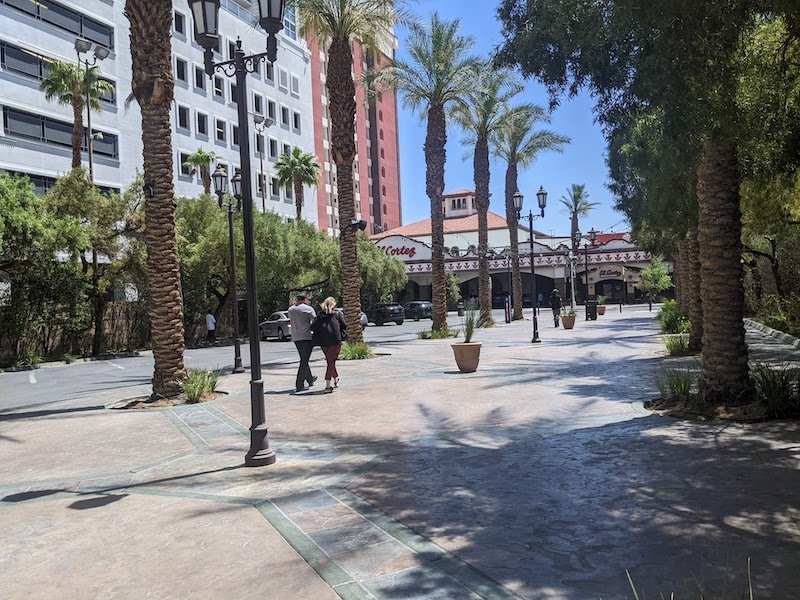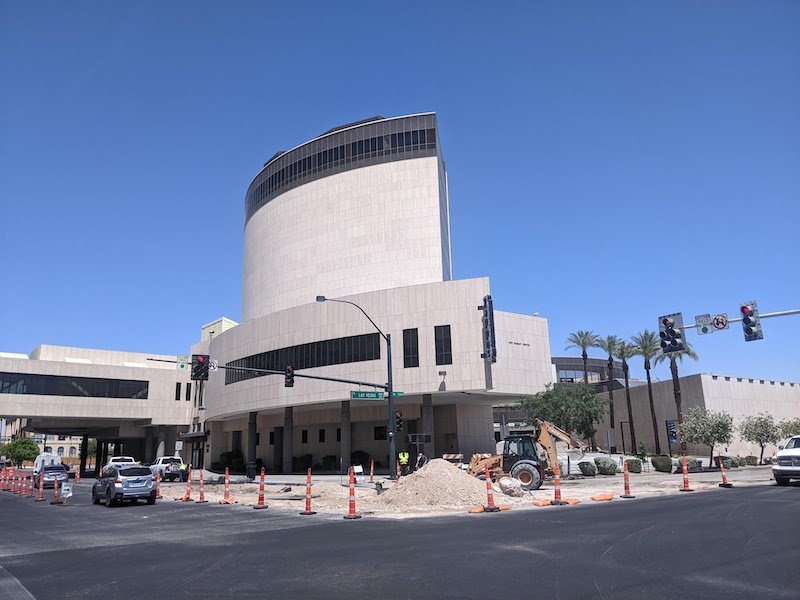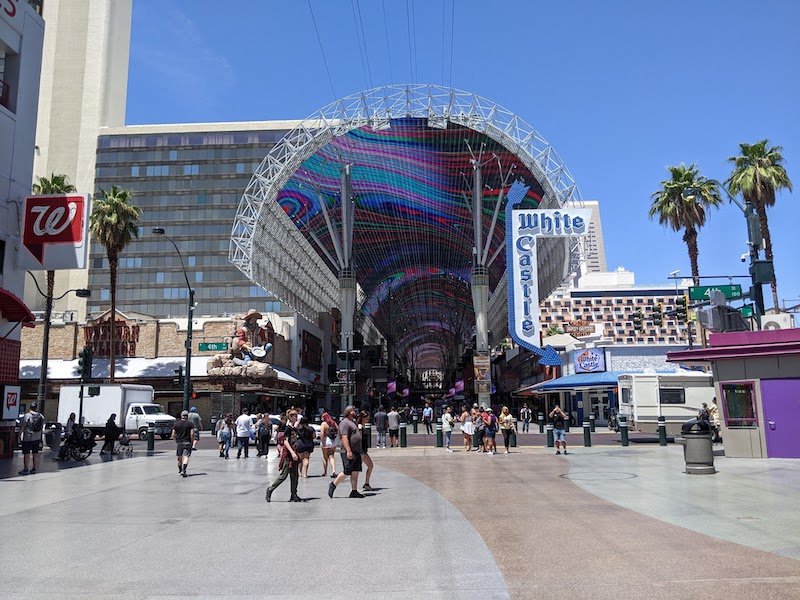Learning From Las Vegas: Tony Hsieh’s Big Gamble
Back in 2014 I was in the live audience here in San Francisco listening to Tony Hsieh speak. He gave a presentation that was partly about the formation of his company Zappos. But more interestingly to me, it was about his attempts at urban revitalization in downtown Las Vegas where his company had relocated. (Feel free to skip ahead to the 20:23 minute mark of the video to get to the downtown Las Vegas segment.)
Zappos sells shoes on the internet. Back in 1999 when the company first launched this was a novel business model. A significant portion of what Zappos does involves a call center where customers interact with company representatives. These jobs are usually pretty unpleasant and don’t typically pay very well. Many companies outsource the entire call center process to other firms with no connection to the primary business. Employees at such places have been known to quit and take a similar job at a competitor’s call center for as little as an extra 25 cents per hour. That turnover is expensive since companies are constantly having to hire and train new employees. And having inexperienced and unhappy workers tends to translate to a mediocre experience for customers which isn’t great for business.
Tony Hsieh decided he could cultivate a high quality work environment and keep his employees happy. That would translate to lower turnover, better customer relations, and a more profitable business. The first step was to relocate the business to a place where there was already a large pool of people with experience in customer service. Las Vegas, with its extensive hospitality industry, was on the top of that list. Nevada is also a considerably less expensive place for both businesses and employees.
Google Earth
At first Zappos operated out of a few generic insular office buildings in Henderson, a suburb about half an hour outside of Las Vegas. This was standard practice for most companies at the time. Employees lived in garden apartment complexes, condos, or tract homes and drove to work in private vehicles. Giant parking lots. Huge highways. Big box stores. Nothing out of the ordinary. Reviews of Zappos from call center workers from that time were generally positive, although it’s clear Hsieh’s corporate culture self selected for a particular variety of extroverts.
These photos from 2018 in Silicon Valley show the typical corporate campus of many companies at that time. The functions of a town were internalized and heavily subsidized. Breakfast, lunch, dinner, auto repair services, pet care, dry cleaning, massage, sports and entertainment… It was all managed and provided by the company in-house. There was no need to ever leave the suburban enclave.
As Zappos grew and needed additional space Hsieh made the decision to move to a single larger property in downtown Las Vegas. The new building, complete with an adjacent parking deck, was actually the old 1973 Las Vegas City Hall. The government had outgrown the facility which had remained vacant for some time.
Now, this is where I need to point out a not so obvious little tidbit that’s fairly important. Las Vegas (the municipality) is unrelated to “Las Vegas” the tourist destination. Apples and oranges. What most people think of as Vegas is built entirely and intentionally in unincorporated Clark County, Nevada and is wholly outside the territory of the City of Las Vegas. Decades ago corporate casinos decided they wanted more control over their regulatory affairs so they built their tourist infrastructure beyond city limits.
The city of Las Vegas began as a railroad stop along a small creek that was settled by Mormons. Downtown has the characteristic look and feel of most American neighborhoods from the early 1900s. And like so many other downtowns, the older parts of Las Vegas have seen better days. Enormous growth in the suburbs along new highways and the decline of rail service made downtown redundant. The Vegas Strip outside of town took the shine off vintage hotels and casinos.
Hsieh decided that he could both please his employees and revitalize downtown by integrating the company into the old urban fabric rather than hold up inside a corporate bubble. He began by reached out to entrepreneurs who already existed in downtown. He made numerous relatively small investments in people who dreamed of starting or expanding their own small businesses. He also lived in a hotel a block away from Zappos headquarters and invited a variety of interesting people from around the country to come live in the building at his expense. These were artists, writers, and characters of all stripes. Some guests lived year round, but many flew in and out for short term stints. There was a continuous rotation of thoughtfully chosen personalities in the neighborhood each contributing to the vibe on the street.
I believe there are very few truly bad buildings. Style all by itself is a matter of interpretation so long as the underlying structure and mechanical systems are adequate. Anything can be shined up and celebrated on its own terms. Helena Rubinstein, the cosmetics mogul, once famously quipped, “There are no ugly women, only lazy ones.” The same is true of a cheap old motel. Everything can be brought back to life and made to be a better version of what it already is.
Activities were coordinated with the Downtown Project to spur revitalization. Turning a giant parking lot into a destination made largely of used shipping containers and funky art projects attracted a lot of attention and served as an incubator for small local businesses. Museums, music festivals, and cultural foundations were established and built upon. The primary goal was to make downtown a more pleasant place to live for permanent residents, not just attract tourists - although visitors were certainly welcomed.
In 2009 Amazon bought Zappos for $1.2 billion. Tony Hsieh personally received a considerable percentage of that money. He used a portion of that cash for his passion projects in Vegas. Each incremental improvement added to the overall success of the neighborhood, contributed to a better quality of life, attracted additional residents, generated higher property values, increased tax revenue to support city services, and so on. Along the way - so the theory goes - Zappos became a better place to work and downtown was better for having Zappos and its employees.
By the time I arrived in Vegas to check out how these efforts were progressing a series of setbacks had already unfolded. Amazon kept its promise to allow Zappos to operate independently in the beginning. But as always occurs in such mergers and acquisitions, little by little Zappos was folded into the mainstream of the larger Amazon operation with the inevitable change in business culture.
Then Covid hit in spring of 2019. The ensuing pandemic health lockdowns sent employees home to work remotely. The public realm of downtown was seriously compromised. Not all the businesses survived. Zappos headquarters was mothballed and remains completely vacant. They won’t be coming back.
Lastly, Tony Hsieh died in a fire at his girlfriend’s house in Connecticut in November of 2020. He was 46 years old. Hsieh had begun to lose interest in both Zappos and the Downtown Project even before he died. But upon his death his family immediately began selling off his roughly 100 Las Vegas properties en masse. The Downtown Project was rebranded as DTP Companies and continues to function in a reduced capacity.
Meanwhile, there’s a four or five block stretch of downtown Las Vegas where a completely different revitalization plan was implemented before Hsieh officially entered the picture. In the early 1990s municipal authorities were concerned that downtown was failing. They marshaled their collective expertise and made a plan. It will come as no surprise that elected officials in Vegas are closely tied to the tourism and gaming industries. Say what you want about the giant machine that is Las Vegas - the good, the bad, and the ugly - but they’re exceptionally good at what they do. And they really only do one thing. They conjure money from a wasteland with shiny lights, titillation, and illusion.
In 1995 the Fremont Street Experience was created by the late Jon Jerde who also helped create the Mall of America in Minnesota, Universal CityWalk in Los Angeles, the Bellagio and Wynn on the Vegas Strip, the Gateway in Salt Lake City, Santa Monica Place, as well as many other similar projects around the world. Jerde was the preeminent architect of consumeristic “experiences.”
Jerde’s design preserved and celebrated the original kitschy vintage properties of Old Las Vegas. Fremont Street was covered with a continuous electronic canopy. The newly formed pedestrian arcade underneath was simultaneously sheltered from the harsh desert sun while visitors were treated to an extravagant light show. At the time everything about the plan was controversial. Not all property owners were on board with eminent domain or the expenditure of taxpayer money for the structure. And there were no guarantees the plan would succeed.
Looking back the Fremont Street Experience has made a difference for the immediate properties and helped goose revenue for the city. But like most such destination “experiences” it’s exquisitely crafted to pull people in and maximize profits internally. It happens to be in an older neighborhood, but it could just as well exist in isolation. It’s a theme park shopping mall with some titties and plumage that thrives on churn and isn’t particularly integrated with its surroundings. Most of the adjacent buildings are actually multi-story parking garages. The steady flow of visitors wandering up and down Fremont Street tend not to venture beyond the electric glow. That’s a feature, not a bug.
What lessons can be gleaned from old Las Vegas for other towns looking to revitalize themselves? The decline of Main Streets is a continent wide phenomenon. There’s a temptation to mimic the latest trend. Baltimore built an aquarium on its inner harbor and suddenly everyone proposed an aquarium in their town. An “Indian” casino made record profits in an obscure location and suddenly every town in America started to look under the couch cushions to see if they could revive a tribe and grant them gaming rights. A premium outlet mall was a great gimmick for a while. Now there’s one in every struggling third rate town in the country. These things work for a while until the landscape is saturated and the concept becomes passé.
I’ve traveled around for decades in search of answers to what makes something work in one location and not in others. What I’ve learned is simple. These grand projects are like tattoos, body piercings, and trendy hairdos. If you’re attractive you don’t need them. If you’re ugly they don’t help.


















































